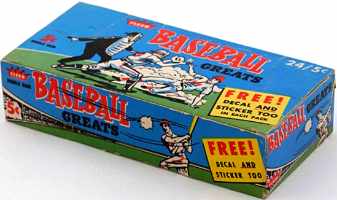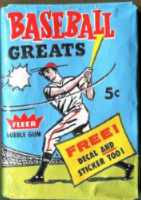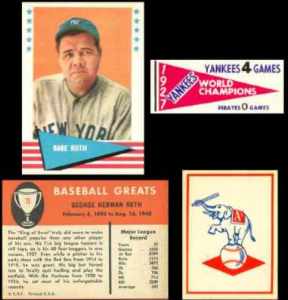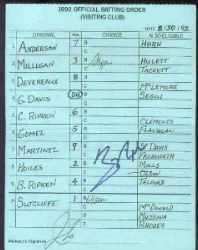Nolan Ryan - 2001 Topps Archives Reserve Reprint REFRACTOR #97 (Mets)
REFRACTOR parallel issue reprints a modified version of his 1968 Topps rookie card.
| Grade |
NM/MINT |
| Book Value |
n/a |
| Our Price |
$ 15.95
Add to cart
|


Below are short bits & pieces on sportscard & baseball trading card collecting.
Please wander around the website for more info, prices, values & images
on vintage baseball, football, basketball, hockey, sport and non-sports cards.
1961 Fleer Baseball Cards


The 1961 Fleer baseball set contained 154 regular-sized cards
honoring careers of Hall-of-Famers Babe Ruth, Walter Johnson,
Lou Gehrig, Honus Wagner, Ted Williams and many lesser
known old-timers.
Released in 2 series, the 2nd series cards #89-#154 are somewhat
tougher to find.
Fleer was prevented from using current players by Topps'
exclusive rights, so they issued their Baseball Greats set using
retired players, managers, executives and the two league
commissioners. Luckily Fleer had their own exclusive rights deal
with Ted Williams, who quickly became the most in demand card in
the set.
 Unfortunately the weak card design and retired players made it a
giant dud with kids and the product was not well received.
Unfortunately the weak card design and retired players made it a
giant dud with kids and the product was not well received.
Cards were sold in five-cent packs and packaged with two special
inserts; a logo team decal and team pennant sticker of past World Series
champions.
Click for complete
1961 Fleer Baseball Cards
Note: You may be on that page right now.
|

Authentic Major League SIGNED
Game-Used LINEUP Cards (PSA)

These are the official lineup cards SIGNED BY THE MANAGER & given
to the home plate umpire before the game with the team's line-up
& batting order !!! Making them even neater, often managers made
lineup changes on these cards throughout the game.
These official lineup cards were SIGNED BY THE MANAGER and presented
to the home plate umpire before the game. They detailed the team's lineup and
batting order. Managers often made lineup changes on these cards throughout
the game, making them even more unique.
Collectors say "They are official documents of a particular game, so they are
absolutely historically relevant. The manager, he was the general in the war.
Imagine owning Eisenhower's list of who he wanted to go into battle, and then he
signed it !!! Imagine what that would be worth?"
The first dugout lineup cards were seen around 1960. Along with lineup
cards, most ended up in the trash after games, making them quite rare today.
MLB saw the light and started marketing them directly in the 2000's.
Astronomical prices have been paid for cards from special games.
$165,010 for the Red Sox dugout lineup card from Game 4 of the 2004 World Series.
$138,000 in 2007 for 1st ever All-Star Game batting order cards.
$ 40,000 for batting order cards and the pen used to fill them out from
Cal Ripken's 2,130th & 2,131st games.
Click for complete
Major League SIGNED Game-Used LINEUP cards
Note: You may be on that page right now.
|


Tobacco Cards
Starting approximately in 1886, sportscards, mostly baseball cards, were often
included with tobacco products, for promotional purposes and also because the
card reinforced the packaging and protected cigarettes from damage. These sports
cards are referred to as tobacco cards in the baseball card hobby. Over the next
few years many different companies produced baseball cards. Tobacco cards soon
started to disappear as the American Tobacco Company tried to develop a monopoly
by buying out other companies.
They were reintroduced in the 1900s, as American Tobacco came under pressure from
antitrust action and Turkish competition. The most famous and most expensive,
baseball card is the rare T206 Honus Wagner. The card exists in very limited
quantities compared to others of its type because Wagner forced the card to be
removed from printing. It is widely (and incorrectly) believed that Wagner did
so because he refused to promote tobacco, but the true explanation lies in a
dispute over compensation.
Soon other companies also began producing baseball and football cards. Sports magazines
such as The Sporting News were early entries to the market. Candy manufacturers
soon joined the fray and reflected a shift toward a younger target audience for cards.
Caramel companies were particularly active and baseball cards were one of the first
prizes to be included in Cracker Jacks. World War I soon suppressed baseball card
production.






 The 1961 Fleer baseball set contained 154 regular-sized cards
honoring careers of Hall-of-Famers Babe Ruth, Walter Johnson,
Lou Gehrig, Honus Wagner, Ted Williams and many lesser
known old-timers.
The 1961 Fleer baseball set contained 154 regular-sized cards
honoring careers of Hall-of-Famers Babe Ruth, Walter Johnson,
Lou Gehrig, Honus Wagner, Ted Williams and many lesser
known old-timers.  Unfortunately the weak card design and retired players made it a
giant dud with kids and the product was not well received.
Unfortunately the weak card design and retired players made it a
giant dud with kids and the product was not well received.  These are the official lineup cards SIGNED BY THE MANAGER & given
to the home plate umpire before the game with the team's line-up
& batting order !!! Making them even neater, often managers made
lineup changes on these cards throughout the game.
These official lineup cards were SIGNED BY THE MANAGER and presented
to the home plate umpire before the game. They detailed the team's lineup and
batting order. Managers often made lineup changes on these cards throughout
the game, making them even more unique.
These are the official lineup cards SIGNED BY THE MANAGER & given
to the home plate umpire before the game with the team's line-up
& batting order !!! Making them even neater, often managers made
lineup changes on these cards throughout the game.
These official lineup cards were SIGNED BY THE MANAGER and presented
to the home plate umpire before the game. They detailed the team's lineup and
batting order. Managers often made lineup changes on these cards throughout
the game, making them even more unique.
